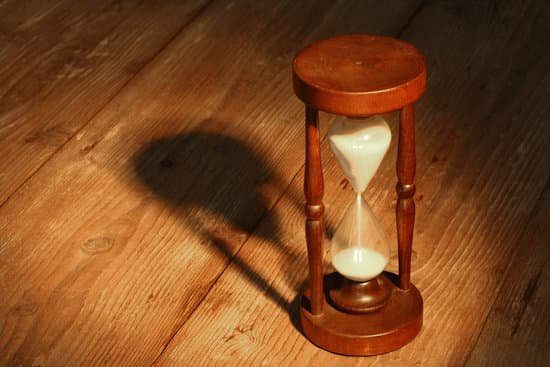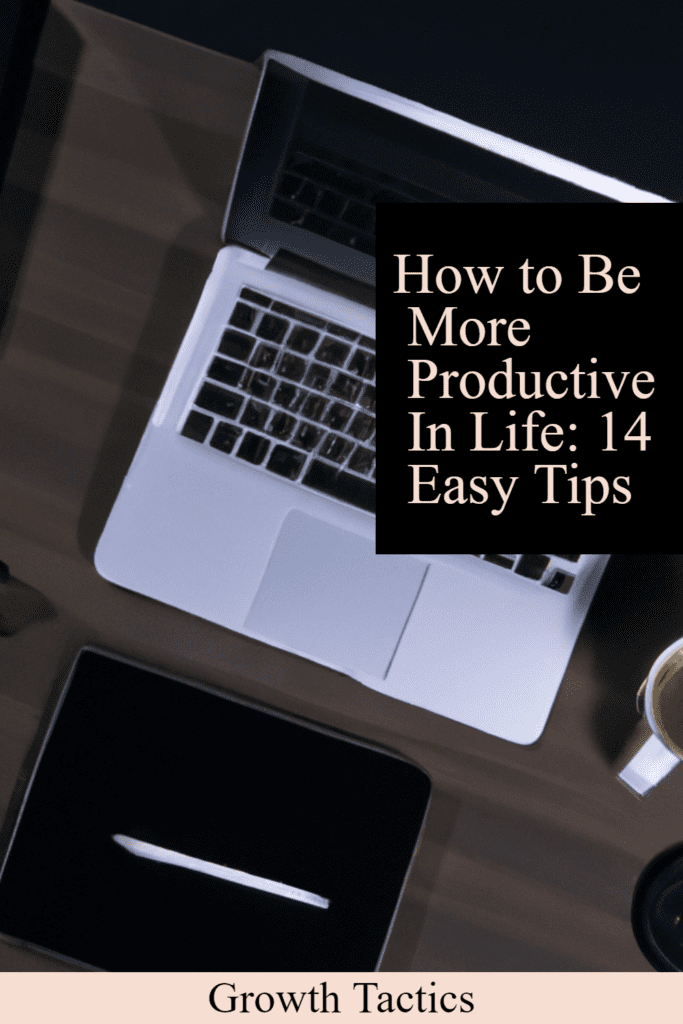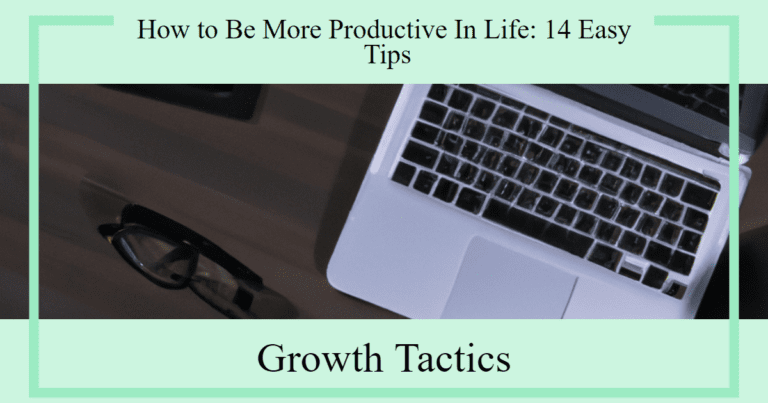Would you like to know how to be more productive at work and home and get more done? What could you do with an extra few hours in your day? We all wish we had more time in our day, but no matter what we do 24 hours is what we have each day.
What we can change is how we use the time we have each day. If we can increase efficiency and use our time more productively, we can get more done. This will give you the feeling of having more time in your day. All it takes to increase productivity and efficiency is a few tweaks and minor changes.
Follow the tips below on how to be more productive at home and at work and you will see your accomplishments soar.
Jump To Section
How Do We Define Productivity
Oxford Dictionary defines productivity as “the effectiveness of productive effort, especially in industry, as measured in terms of the rate of output per unit of input.” I define productivity as how much I get done in a finite amount of time. In this equation, we can’t really add more time but we can find ways to increase efficiency and get more done in the time we have.
What is the Productivity Equation
There’s even an equation used to calculate employee productivity. Productivity = total output divided by total input. For example, if you have an employee working for 10 hours and they produce $1,000 worth of goods, productivity = $1,000 divided by 10 or $100 an hour. Although the productivity equation can be useful in some instances, it doesn’t always take all factors into account so be careful basing decisions solely on it.
What is Toxic Productivity?
Toxic productivity refers to the idea that productivity can become harmful when it is taken to an extreme level, causing stress, burnout, and negative effects on mental and physical health. It is the belief that one must constantly be productive, efficient, and successful, regardless of the cost or toll it takes on their well-being. This can lead to an unhealthy focus on work and achievement, often at the expense of other important aspects of life, such as relationships, hobbies, and self-care.
Toxic productivity can also manifest in the pressure to constantly optimize and improve one’s productivity, even when it is not necessary or beneficial. This can lead to a cycle of burnout and exhaustion, as individuals push themselves to do more and more, without taking the time to rest and recharge.
It is important to recognize that productivity is not the only measure of success and that taking breaks and prioritizing self-care are essential components of a healthy and balanced life. It is crucial to find a healthy balance between productivity and rest and to prioritize mental and physical well-being above all else.
How to Be More Productive In Life and Increase Efficiency
1. Use Technology to Your Advantage

I know technology can sometimes hurt productivity, but if used correctly it can be a great tool to help increase efficiency. There are lots of apps and programs out there to help people increase efficiency. Microsoft Outlook has a calendar where you can put important meetings and deadlines, to-do lists that you can track all your tasks on, and reminders that let you know you have something coming due.
There are also many productivity apps that you can download to your phone that can be very helpful. Trello is a great app used to increase productivity and project management. You can even share tasks with team members. There are apps for all different kinds of ways to increase efficiency like do not disturb apps to turn off notifications on your phone, email organizers to help manage your inbox, timers to help get the work/break ratio right, and so many more.
Additional Productivity Apps
- Todoist – Task management tool for individuals.
- Wunderlist – Task management software for teams or individuals.
- Slack – This is a messaging app where members can have multiple channels with various team members.
- Taskade – Project management/collaboration tool.
- Doodle – Collaborative scheduling/calendar app.
- Toggl – Time tracking app for finding deficiencies in your time management.
- Zapier – A useful tool for automating tasks. For example, you can set it up to send an email out to everybody on the team when something is updated in Trello.
- Notion – A collaborative note/document tool.
- Serene – A tool for breaking the work on tasks into short power sessions to prevent mental fatigue.
2. Limit Distractions
There’s nothing worse than being in the groove, really knocking stuff out then the phone rings and your attention gets pulled away to something else. Distractions can severely impact productivity. Distraction comes in many different forms, coworkers or subordinates, emails, friends, bosses, and just about anything else that pulls your attention away from the task at hand. Eliminating or minimizing the effects of these distractions will increase productivity and efficiency.
You can’t just tell your boss not to bother you but many other distractions can be minimized or eliminated. Avoid constantly checking emails. Set times to check your emails every 30 minutes. Save social media for break times. When you are trying to get something done Facebook or Instagram can be a huge distraction. Putting your phone on do not disturb will greatly increase efficiency while working.
Know what times you are normally most productive and try to schedule meetings outside of that time. Use these high productivity times to get the tasks that require your focus completed. Knowing and correctly using your times of high efficiency will increase productivity.
3. Take Breaks

If you are plugging away too long with your work, your work quality will begin to suffer, and it becomes easier for you to get distracted and lose focus. Sometimes you must force yourself to take a break even if it’s a short one. Working for 45 minutes and then taking a 5-10-minute break can be very advantageous. Just that short break can increase efficiency significantly.
Get up and stretch, take a walk, do some pushups, check your phone, get on social media, or go get a coffee. Whatever you do make sure it gets your mind off your job. It’s best if you can leave the work area just to get your mind off it for a few minutes.
4. Make a To-Do List
To-do lists are a great tool to increase productivity and efficiency, ultimately increasing the amount of work you get done. Lists not only help you remember tasks that need to be done but also make it easier to prioritize tasks. Taking five minutes to make a to-do list can save you a ton of time in the long run.
A great time to make a to-do list is either at night or first thing in the morning. That way you start your day off with a game plan. Having a game plan will help your day progress smoothly instead of finishing a task and having to think about what task you must do next.
For a great to-do list program and app check out Clockify.
5. Track Time Spent on Tasks
Tracking the time spent on tasks can help you see where you are spending your time. This can be very useful for figuring out which tasks are wasting a lot of your time without giving you much payoff. This is useful to track how much time you are wasting not being productive. This can open your eyes, revealing how you spend your time. Eliminating waste will increase efficiency and productivity. You track your time the old-fashioned way by using a clock and notebook but there are apps out there that will do a lot of the work for you.
6. Set Your Own Deadlines

Everyone hates deadlines but they aren’t so bad when you set them for yourself. Self-imposed deadlines can help keep you on track and increase productivity throughout the work day.
Everything on your to-do list should have a timeframe of when you are going to get it done. This helps you prioritize tasks that are due soon and things that may be able to be put off for a little while.
Just make sure you are not putting off tasks that will take some time until the last minute. Deadlines should be realistic because if you keep busting your deadlines it may become very frustrating.
7. Know and Use the Two Minute Rule
The two-minute rule can be useful in helping to not get overwhelmed and will increase productivity and efficiency by getting you in rhythm. For any task that takes less than two minutes, just go ahead and knock it out. This is a great way to increase efficiency instead of allowing tasks to pile up.
Anything that pops up and will take more than two minutes should be added to the to-do list unless the task is urgent. This can help you stay focused instead of switching between tasks every time something new pops up. Don’t be afraid to ignore the task until you finish the task at hand. This will save time in the long run.
8. Focus on One Task at a Time
Many people believe they are good at multitasking, but multitasking can kill productivity. Even if you think you are good at multitasking, you have to stop one task to switch to another task. The brain can only really concentrate on one thing at a time. Even if you don’t notice it, once you stop a task it can be a lot harder to get started on that task again.
It is normally better to get one task fully completed than get five tasks started and none completed. The only time it may be better to switch tasks is when you get completely stuck on a task and taking a break doesn’t help you get unstuck. Focusing on one task at a time will increase efficiency on that task and will allow you to get more done.
When you need to maintain laser-focused attention, the Pomodoro Technique can be a game-changer. This method involves working on a single task or a group of smaller tasks for 25 minutes straight, known as a “Pomodoro,” followed by a 5-minute break. After completing four Pomodoros, take a longer break of 15-30 minutes. This cycle helps maintain concentration while giving your brain periodic rest, making it easier to sustain productivity over longer periods.
9. Use Downtime Effectively

Find ways to use downtime effectively. I know what some of you are saying “I don’t have any downtime.” What about your daily commute? The morning is a great time to listen to an audiobook. The afternoon commute is a great time to reflect on how the day went. When you are waiting for a meeting to begin you can review your to-do list or use the time to check emails on your phone. Whether you realize it or not there is plenty of time to make yourself better or reflect on tasks and priorities.
For some great free online personal development resources click here.
10. Be Proactive, not Reactive
Don’t just wait for deadlines to motivate you. Get on top of tasks and get them done before they are due. This will help you not become overwhelmed by deadlines. Don’t worry you won’t run out of work. There’s always work to be done. Once you can get caught up with all the tasks on your to-do list, start looking at what will be coming up in the future and start knocking that out.
11. Keep Your Work Area Clean and Organized
A messy and disorganized work area can hurt productivity. Not only can it be hard to find things, but it can also be a mental barrier. The more stuff in the work area the easier it is to get distracted. As discussed earlier distractions should be kept to a minimum for the highest productivity. If your work area is messy take 10 to 15 minutes to clean it up. Once it’s clean keep it that way. A clean work area will increase productivity.
12. Quit Spending so Much Time on Tasks that Don’t Matter
We do a lot of tasks that have very little payoff. You can be more efficient by eliminating a lot of these tasks. These tasks can take a lot of time. While prioritizing tasks we need to determine if the tasks are worth our time.
What are the consequences if you don’t do this task? If it won’t affect you, your job, the company, or your team, then it might not be worth doing. Even if the task is something that must be done, it may not be worth putting in all the effort trying to make it perfect. It may just be something that you have to get done quickly so you can spend your valuable time on things that matter more.
13. Perfection can Kill Productivity
Being a perfectionist can hurt productivity and decrease efficiency. I’m not saying you should produce garbage. Just don’t spend a ton of time overanalyzing something and trying to make it perfect. If you can get something to 98% in an hour but that last 2% takes you 4 hours, is it worth it? Sometimes the answer may be yes, it’s worth the extra time but typically it’s not. Especially if you have a lot of work on your plate. Many times, getting the work done and off your plate is better than spending a ton of time trying to make it perfect.
14. Avoid Unnecessary Meetings

Many times, we have meetings that last a long time and don’t have a lot of information or the information is only useful for a handful of the people in the meeting. If the same information can be passed on in an email or phone call it may be best to go that route if the option is available.
Not all meetings can be avoided but when you can avoid them, they can save you a ton of time. Typically, an hour-long meeting can be more than an hour of your time. You must quit working on whatever you’re working on. Then show up a little early. Then it takes a little bit to get back into the grove of whatever you were working on before the meeting. When it’s all said and done the meeting can be more than two hours of your time.
Habits for Enhancing Productivity
While various techniques and tools can significantly boost productivity, cultivating certain habits will provide a solid foundation for lasting efficiency and effectiveness.
1. Morning Routines
Establishing a consistent morning routine can set the tone for a productive day. Incorporate activities that prepare your mind and body for the tasks ahead, such as meditation, exercise, or a nutritious breakfast. A well-structured morning helps create a sense of accomplishment early on, boosting motivation.
2. Consistent Sleep Schedule
Good sleep hygiene is essential for sustained productivity. Going to bed and waking up at the same time every day helps regulate your body’s internal clock, leading to better focus and cognitive function. Prioritize quality sleep to rejuvenate and prepare for each day’s challenges.
3. Regular Reflection and Adjustment
Take time at the end of each week or month to reflect on what has been accomplished and identify areas for improvement. This habit of regular reflection helps you adjust your strategies and refine your processes, ensuring continuous improvement in productivity.
4. Batch Processing Similar Tasks
Instead of switching between different types of tasks, group similar activities together and tackle them in dedicated time slots. For example, designate specific times for answering emails, making phone calls, or working on reports. This approach helps reduce cognitive load and minimizes the time lost to switching tasks.
5. Mindful Time Management
Incorporate mindfulness techniques to stay present and focused during tasks. Before beginning a task, take a few deep breaths, clear your mind, and set an intention. This practice can increase concentration and productivity, particularly during complex or demanding tasks.
6. Prioritize Self-Care
Regularly engage in activities that replenish your mental and physical energy. Incorporate habits like regular physical exercise, healthy eating, and hobbies or activities that bring you joy. By ensuring you are well-maintained, you enhance your overall productivity levels.
7. Decluttering and Organizing
A tidy workspace can have a significant impact on your mental clarity and workflow efficiency. Make it a habit to clean and organize your work area regularly. Remove unnecessary items, organize tools and materials, and maintain a clutter-free environment to enhance focus and reduce stress.
8. Seek Continuous Learning
Adopting the habit of continuous learning can contribute significantly to productivity. Engage in activities that expand your skills and knowledge, like reading books, taking online courses, or attending workshops. Keeping your mind agile and informed helps you tackle tasks more effectively.
9. Practice Gratitude
Starting or ending your day with a moment of gratitude can positively impact your overall mindset. Reflect on what you are grateful for and acknowledge the progress you’ve made, no matter how small. This habit fosters a positive attitude, which is crucial for maintaining motivation and productivity.
Have a Productivity Plan
Having a productivity plan is a crucial step toward achieving your goals and maximizing your potential. By taking the time to identify areas where you can increase efficiency and productivity, you can create a roadmap that can help you stay on track and achieve success in less time.
When creating your productivity plan, it’s important to start by setting clear and measurable goals for yourself. Whether you’re looking to increase your productivity at work, manage your time more effectively, or develop new habits that support your goals, having a clear idea of what you want to achieve is key. Once you have identified your goals, you can then begin to create a plan that outlines the specific steps you need to take to achieve them.
It’s important to review your productivity plan often to ensure that you are staying on track and making progress toward your goals. This can involve checking in on your daily or weekly routines, adjusting your plan as necessary, and adding new strategies to increase efficiency and productivity. By regularly reviewing your productivity plan, you can stay motivated and focused on achieving your goals, even when faced with challenges or setbacks.
Ultimately, having a productivity plan is a powerful tool that can help you make the most of your time and achieve the success you desire. So if you’re ready to increase your efficiency, develop new habits, and reach your full potential, start creating your own productivity plan today!
Final Thoughts
To be more productive, many times, it just takes some minor tweaks. The most important part is looking at yourself and seeing where to improve. Use these productivity tips to help you get out there and be your best.
Did you enjoy this article on how to be more productive in life? Please don’t forget to share below.


